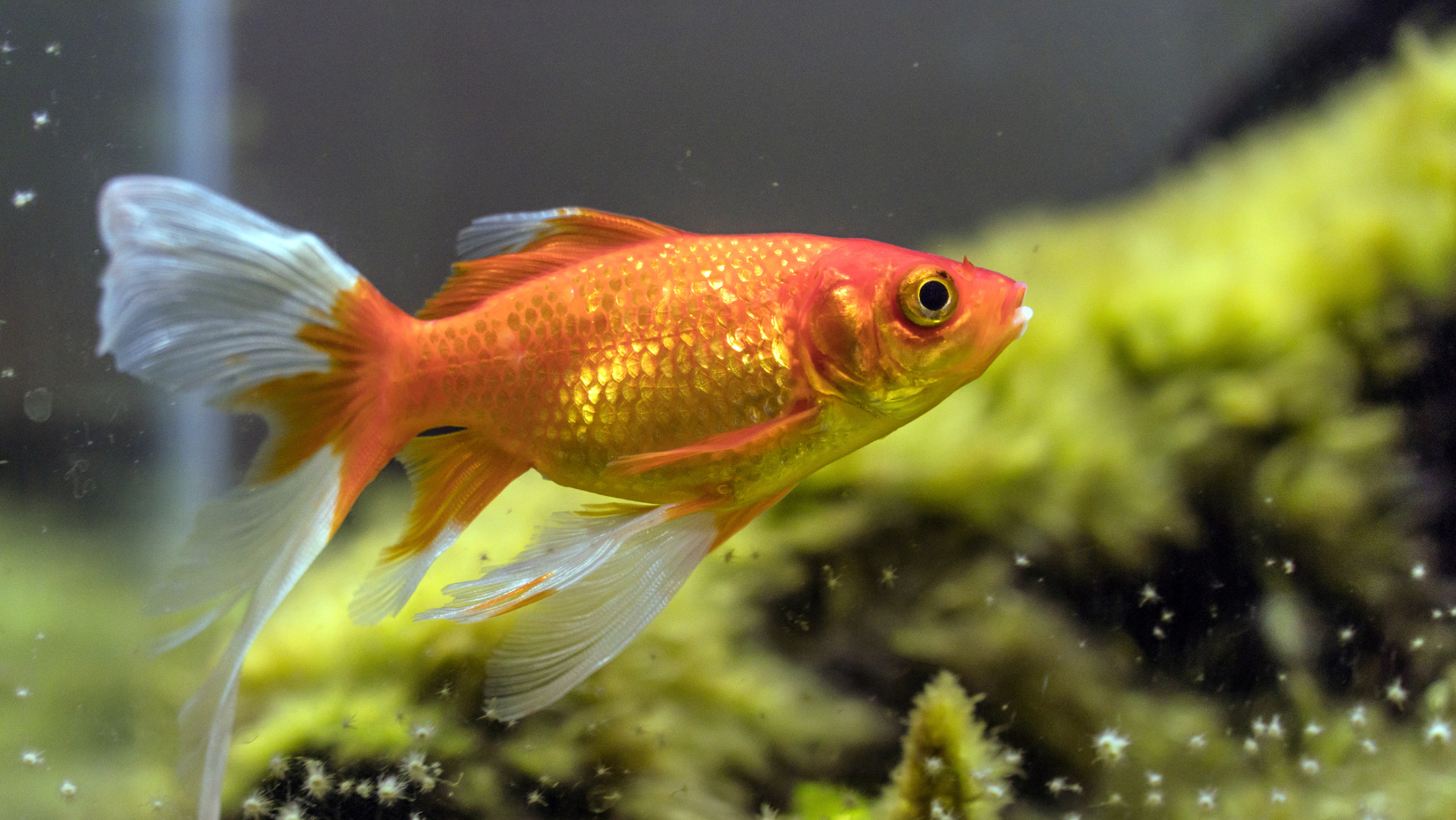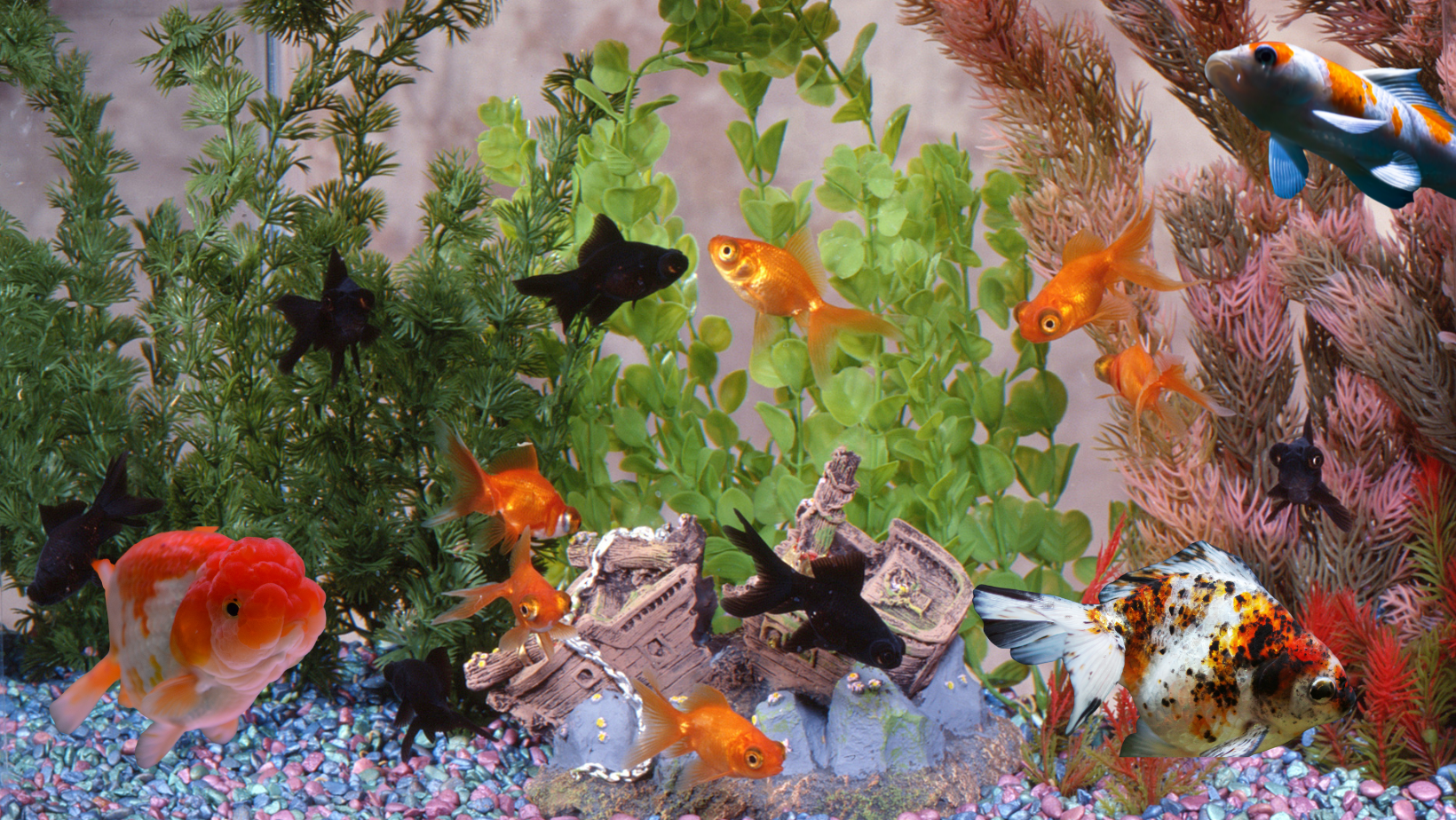Gold Fish
Carassius auratus
Gold fish, or "Carassius auratus" as they are known by their scientific name, were first bred in places like China and Japan about four to five hundred years ago.
Every goldfish, often looking quite dissimilar, is derived from the very first brown-colored carp-type fish which, after its first genetic change, became the more familiar orange color we know today.
Indeed, you can see many different varieties of goldfish but they are all related.
The common goldies is stronger and hardier but the more fancy types are harder to keep successfully.
This is because of the various mutations of the gene pool but on the positive side has created the often striking and weird-looking features.
That being said ALL types of gold fish can be interbred and it is more often the case that these types of "rare" mutations are the more sought after type of fish for hobbyists and fish enthusiasts.
Who wouldn't want to keep fish like these beauties?

Gold Fish:
Common Types
The common types of goldies these days include:
* Common gold fish:
* Comets;
* Shubunkins;
*Fantails;
* Blackmoores;
* Ryukin;
* Bubble-eyes;
* Lionheads;
* Pearlscales;
* Oranda;
* Telescope-eyes;
* Celestial-eye;
* Butterfly-tails;
* Ranchus;
* Veiltails;
* Pompons.

Even though they are quite hardy most gold fish types generally need to have their tank cleaned about every one to two weeks because they produce a high amount of waste matter which can cause the water conditions to become quite unhealthy.
If you change about a third of the tank's water every one to two weeks you will generally have satisfactory conditions to keep these fish successfully for many years.
It is also advisable to give these fish plenty of room in a good sized tank as they use up a lot of oxygen as they swim and forage for food, often digging up gravel and un-potting plants in their quest.
Really, the bigger the tank you can afford the better for the fish's longevity.
Indeed most goldfish will live several years at least if looked after properly. Some have been known to last over 40 years!
Most will grow to around 10 centimeters but they can grow in excess of 30 centimeters depending on tank conditions of temperature and chemical composition.
As for food, goldfish do appreciate a diet of both vegetable and animal matter being omnivorous, but this can best be served by a good fish food formula from your local hobby or aquarium store.
These commercially produced foods contain the right amounts of protein, vitamins and minerals to keep your goldfish happy and healthy.
You should only feed them enough so that all the food is consumed in approximately five minutes.
Gold Fish:
Water Quality
A important component in the development of sickness in goldfish is overfeeding. By adversely affecting water quality and modifying the chemical composition, it disturbs the delicate ecosystem's equilibrium in the aquarium and finally results in severely contaminated water. The effects of overfeeding and their implications for the health of goldfish and the quality of the water are further discussed in this section.
Impact on Water Quality: Unconsumed food that is overfed to goldfish sinks to the bottom of the tank and begins to degrade. Proteins and carbohydrates are among the chemical substances that are released into the water when the meal breaks down.
These substances start to pollute, which causes the quality of the water to drop down quickly. Food decay uses up oxygen and generates ammonia, nitrites, and nitrates, which are toxic to goldfish if present in high concentrations. Goldfish's gills may get damaged by elevated ammonia levels, which can also impact their general health.
Increased Pollution: The buildup of organic waste from rotting food serves as a haven for dangerous germs and fungus. As a consequence, the tank's bacteria population can increase fast, further decreasing the water's quality and increasing the likelihood that someone will become sick. Because of the increased pollution, goldfish are stressed, which weakens their immune systems and makes them more vulnerable to various illnesses and disorders.
Unbalanced Nutrition: Overfeeding goldfish might also result in unbalanced nutrition. They could not get the right mix of vital nutrients if they eat more than is required. Their digestive systems might get overworked by consuming too many proteins or fats, which could lead to health issues including fatty liver disease. Additionally, overeating may result in obesity, which shortens lifespan and puts additional burden on organs.
For maintaining ideal water conditions and boosting goldfish health, it's essential to avoid overfeeding. The following rules should be followed by goldfish owners:
Feed goldfish in portions that they can finish in a few minutes, then take away any leftover food. a. Feed Appropriate Portion Sizes. By doing this, surplus food is kept from building up in the tank and overfeeding is avoided.
A. Keep a Consistent Feeding Schedule: Create a regular feeding schedule to make sure that goldfish eat at regular intervals. This lessens the possibility of overfeeding brought on by irregular feeding patterns and helps avoid overeager feeding.
B. Provide Species-Specific Diets that Are Balanced: Use premium goldfish food that has been specially developed to fulfill their dietary requirements. To promote optimum development and general health, these diets include the proper combination of proteins, carbs, vitamins, and minerals.
C. Keep an Eye on the Behavior and Physical Condition: You really need to keep track of their eating schedule and general health. Unusual alterations, such reduced activity, bloating, or obesity, may be signs of overeating and need to be treated right away.
By following these guidelines, goldfish keepers may maintain a balanced feeding schedule that promotes their fish's health as well as a clear and orderly aquatic environment.
Gold Fish:
Ideal Conditions
The ideal conditions vary slightly for different types of goldfish (see individual pages) but generally the approximate temperature range should be from 15 degrees C to 25 degrees C. The pH ranges from around 6 to 8 and of course, they are freshwater fish! The water should also be moderately hard.
If you're going to breed goldfish then you must realize it is very hard to get them to breed in overcrowded conditions.
This means both the size of the tank and the number of fish in it.
And remember, you can breed just about any type of goldfish with any other type of goldfish.
Indeed, it is often desirable to do this because the unusual features it can produce makes them highly prized.
Remember also though that the more they are "in-bred" the weaker will be their physical constitution. in other words, they'll be more prone to disease and infection and probably have a shorter life span as well.
Keeping goldfish is a pleasant and enjoyable hobby which can give you many years of enjoyment.
Children can learn valuable lessons of responsibility and caring for living creatures also so it is a great thing for them to get involved with too.
So there it is...great pleasure and something that can bring the family closer together. Just some benefits of keeping gold fish.
More Gold Fish Info...
For further info on
gold fish click here...
Let's look at some of these goldfish in more detail...
Good luck and enjoy!